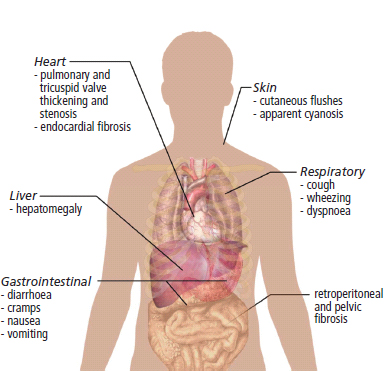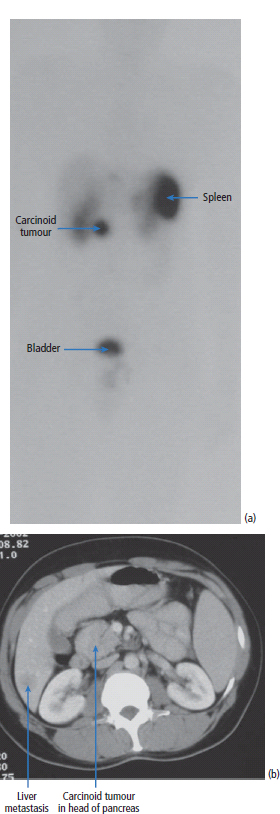23 Carcinoid syndrome appears frequently amongst Dr House’s differential diagnoses but only turns out to be the final correct diagnosis in one episode (“Here Kitty”). This episode also includes the nursing home cat that only seems to visit people shortly before they die. House concludes that the cat is attracted to the warmth of the heated blankets on the beds of dying patients, but what does House know about medicine? The term carcinoid was coined by a German pathologist Siegfried Oberndorfer in 1907, meaning carcinoma-like, because of the relatively benign behaviour of these tumours despite their malignant appearance down a light microscope. Carcinoid tumours are neuroendocrine tumours that may arise in numerous anatomical sites, particularly the gastrointestinal tract and lungs (Table 23.1). These are usually well-differentiated tumours, although carcinoids also include the rarer high-grade neuroendocrine tumours. Much of their medical notoriety derives from their secretion of vasoactive compounds that give rise to the carcinoid syndrome. This usually follows the development of liver metastases, when first-pass metabolism of these products is bypassed. Carcinoid tumours are much more common than previously recognized but the true incidence is not clearly known. It is estimated that around 1200 people are diagnosed with carcinoid tumours each year in the United Kingdom. Patients with carcinoid tumours may be asymptomatic or may present with symptoms due to the secretory products of their tumour. These metabolic products cause diarrhoea, flushing and occasionally bronchospasm (Figure 23.1). These symptoms are so specific that there is little difficulty in making a diagnosis, which is often achieved in general practice (see Chapter 45). The carcinoid syndrome of symptoms usually occurs with small bowel carcinoid tumours after the development of liver metastases but may occur without metastatic spread from bronchial carcinoid tumours. Carcinoid heart disease develops in up to half patients with 5HT-producing neuroendocrine tumours. It is due to the formation of fibrous plaques within the heart, causing valvular dysfunction. Classically, the valves affected are right-sided. Right-sided heart failure due to valve disease is treated surgically by valve replacement. In view of the underlining excellent prognosis for carcinoid tumours, this condition is actively treated. Carcinoid tumours also lead, because of their secreted products, to fibrosis at other sites, such as in the retroperitoneum, where it may lead to small bowel obstruction. Table 23.1 Comparison of carcinoid tumours by site of origin ACTH, adrenocorticotrophic hormone; 5HIAA, 5-hydroxyindole-acetic acid; 5HT, 5-hydroxytryptamine (serotonin); 5HTP, 5-hydroxytryptophan. *Multihormones include tachykinins (substance P, substance K, neuropeptide K), neurotensin, PYY, enkephalin, insulin, glucagon, glicentin, VIP, somatostatin, pancreatic polypeptide, ACTH and α-subunit of human chorionic gonadotropin. The presence of symptoms is likely to indicate that the patient with a carcinoid tumour has metastatic disease. The examination of such a patient should be confined to establishing the extent of disease and obtaining a histological diagnosis. The investigations that are required include a blood count, liver function test, chest X-ray and a CT scan of the chest and abdomen (Figure 23.2). Twenty-four-hour urinary 5-hydroxyindole acetic acid (5HIAA) levels should be measured. This is because 5HIAA is the excretory product of the metabolites produced by carcinoids and results from the breakdown of 5-hydroxytryptamine (5HT) or serotonin. There has been interest in the use of both chromagranin A and B as serum markers for carcinoid. This is a neurosecretory product that is of value because we can monitor carcinoid using this as a blood test, rather than having to carry out 24-hour urinary collections to measure 5HIAA. Tumours may be localized by specialized isotope scanning with either an octreoscan or DOTATATE scan. Octreoscan uses a radiolabelled somatostatin analogue, 111indium pentetreotide and scintigraphy, whilst the newer and more sensitive DOTATATE scan uses 68gallium-DOTA-Octreotate and CT/PET imaging. Figure 23.1 Carcinoid syndrome. Figure 23.2 (a) Indium-113-labelled somatostatin scan demonstrating a focus of carcinoid tumour in the pancreas as well as normal tracer uptake in the spleen and bladder. (b) Matched CT scan showing a tumour in the head of the pancreas and liver metastases. Surgical resection of non-metastatic carcinoid tumours is usually curative, whilst the management of metastatic disease is focussed on a combination of pharmacological control of the carcinoid syndrome. The latter includes agents that block the synthesis, release and peripheral blockade of circulating tumour products. The list of drugs used in the treatment of carcinoid symptoms include inhibitors of 5HT synthesis such as parachlorophenylalanine, peripheral 5HT antagonists such as cyproheptadine, antihistamines and inhibitors of 5HT release such as somatostatin and its long-acting analogues. The most frequently used somatostatin analogue is octreotide, and this leads to a relief of symptoms in 80% of patients for a median duration of 10 months. Interferon has been used to treat patients with metastatic carcinoid tumours that have become refractory to somatostatin analogues. Symptom relief will occur in 50–70% patients, but fewer than 5% of patients achieve any significant tumour regression. Treatment with interferon is associated with significant side effects, which may include flu-like symptoms; for this reason, it is not generally given. When metastatic disease in the liver is extensive, hepatic artery embolization, chemoembolization or radioembolization may be considered. This involves selective cannulation of the artery with injection of embolic material. Amongst the substances injected are radiolabelled analogues of somatostatin such as 90yttrium DOTA-octreotide and 90yttrium-embedded microspheres (see Figure 3.12). This will lead to sustained symptom relief in the majority of patients. There may be significant side effects from embolization, and so this procedure is not entered into without due consideration of the benefits. In some clinical series, mortality rates are 3–5%. A “landmark” trial comparing treatment with octreotide with everolimus and octreotide was published in 2011. Everolimus is an orally active inhibitor of the mammalian target of rapamycin, an “mTOR inhibitor”. The progression-free survival of the patients treated with combination therapy was 16 months and for those treated with single-agent octreotide was 11 months. As a result of this excellent study of 429 patients, the combination of octretoide and everolimus is now the “standard of care” for patients with metastatic carcinoid syndrome. The prognosis for patients with metastatic carcinoid tumour is relatively good in comparison to that for most metastatic tumours. Patients with metastatic carcinoid tumour commonly survive a considerable time and the expectation, even in the presence of liver disease, is that approximately 36% of patients will survive 5 years and 20% for 10 years. In the absence of metastases and following resection of the primary, the outlook is excellent. Carcinoid tumours of different primary sites are thought to have different outlooks, but this is very much debated. Case Study: The blushing bride.
Carcinoid tumours
Presentation
Foregut
Midgut
Hindgut
Site
Respiratory tract, pancreas, stomach, proximal duodenum
Jejunum, ileum, appendix, Meckel’s diverticulum, ascending colon
Transverse and descending colon, rectum
Tumour products
Low 5HTP, multihormones*
High 5HTP, multihormones*
Rarely 5HTP, multihormones*
Blood
5HTP, histamine, multihormones,* occasionally ACTH
5HT, multihormones,* rarely ACTH
Rarely 5HT or ACTH
Urine
5HTP, 5HT, 5HIAA, histamine
5HT, 5HIAA
Negative
Carcinoid syndrome
Occurs but is atypical
Occurs frequently with metastases
Rarely occurs
Metastasizes to bone
Common
Rare
Common
Investigations


Treatment
Prognosis
 ONLINE RESOURCE
ONLINE RESOURCE
Stay updated, free articles. Join our Telegram channel

Full access? Get Clinical Tree


